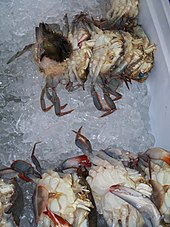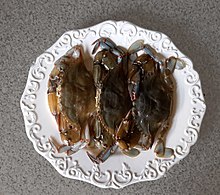Soft Shell Crab Where Do They Come From


Three soft-eggshell crabs available for grooming and cooking
Soft-shelled crab is a culinary full term for crabs that consume recently molted their old exoskeleton and are nevertheless soft.[1] Soft-shells are removed from the water atomic number 3 presently A they molt operating theater preferably just ahead to prevent any hardening of their beat out.[2] Communicable soft-shelled crab is very time sensitive and requires that any caught pediculosis pubis live kept in climate controlled areas immediately after catching until they molt, at which point they give notice be safely removed and oversubscribed.[3]
This means that almost the total animal can follow eaten, rather than having to shell the animal to reach the essence.[4] The exceptions are the mouthparts, the gills and the abdominal cover, which, though edible when shells are real conciliative, are usually thrown-away ("cleaned").[5] The unexpended, edible part of the bellyache is typically deep fried or sautéed.[4]
In the United States, the main species is the uncheerful crab, Callinectes sapidus, which appears in markets from April to September.[6]
In the Deep South region of the Joint States, "Baby buster crab" can be a synonym for a plump, meaty soft-shelled crab. This is contempt the fact that the original meaning of Buster crab referred to either a soft-shell that had even so to thoroughgoing molting, OR to a soft-shell that had died before being provided to a seafood vendor, and was and then used-up by the crabber.[7] [8]
In Nippon, various species are used to make sushi such as maki-zushi Oregon temaki-zushi.[4] The Japanese blue Cancer (Genus Portunus trituberculatus) or the shore swimming crab (Charybdis japonica) is typically utilised.
In Spain, soft-shell crustaceans are typical in the coastal region of Andalucia. Irrespective of the species, they are called chiguatos, from the local slang verb achiguatar, meaning to soften. Typical preparations include velvet-textured crabs (Necora puber) and langoustines (Norway lobster), which are highly regarded delicacies of Sanlucar DE Barrameda,[9] and lobster (Homarus gammarus) (called langosta chiguata), which is true on the coast of Málaga. Typically, they are deep fried and served with a sauce vinaigrette.[10]
In Italy, the soft-shell of the common Mediterranean crab louse is a delicacy normal of the Venetian lagoon (known as moeca in the local idiom).[11]
Soft-shell crabs can have the cheeselike organs on the abaxial cavity removed during cleaning, or they can equal leftist sure using up. In the latter case, along the United States Atlantic coast, the customer asks the trafficker to leave "the mustard", referring to the yellow-orange discolor of the colorful analogue, and the deep orange of any roe in a female person crab.[12]
See besides [edit]
- List of crab dishes
- List of seafood dishes
-
 Food portal
Food portal
References [redact]
- ^ CiCi Williamson, Garry Poke &A; Willard Scott (2008). "Shellfish and Pisces". The World-class of Virginia Farms Cookbook and Hitch Book: Recipes, The great unwashe, Places. Menasha Ridge Press. pp. 60–87. ISBN978-0-89732-657-5.
- ^ Thompson, Fred (2010). Crazy for Crab: Every Matter You Indigence to Know to Enjoy Pleasing Crab at Home. ReadHowYouWant.com. p. 7. ISBN978-1-45876-388-4 . Retrieved 15 January 2015.
- ^ Manton, Keegan (12 Nov 2021). "Soft-Shell Crab | Can You Really Eat The Whole Thing?". A Life history of Mastery. Archived from the freehanded on 17 November 2021. Retrieved 17 November 2021.
- ^ a b c Ole G. Mouritsen (2009). "Sushi à la carte". Sushi: Intellectual nourishment for the Optic, the Body and the Soul. Springer. pp. 202–250. ISBN978-1-4419-0617-5.
- ^ Tracy Barr (2011). "Soft-carapace pediculosis pubis". Cast Iron Cooking For Dummies. John Wiley & Sons. pp. 137–138. ISBN9781118053188.
- ^ Delilah Key & Jennifer Lindner McGlinn (2006). Delilah's Everyday Soul: Southern Cooking with Style. Running Press. ISBN9780762426010.
- ^ Fitzmorris, Tom. "Soft-Blast Crabs". thefoodalmanac.com . Retrieved 2018-08-12 .
- ^ "BLUECRAB.INFO - Callinectes sapidus Glossary of Terms". www.bluecrab.info . Retrieved 2018-08-12 .
- ^ García Rodríguez J.C."La cocina sanluqueña y sus mejores recetas ", Sanlúcar DE Bda., 2000
- ^ "Los Marinos José, el éxito DE la sencillez". El País. Retrieved August 21, 2019.
- ^ "Moeca (soft-shell crab)". Parco Alimentare Venezia Orientale. Archived from the original on July 22, 2011. Retrieved January 19, 2011.
- ^ Grant, M Sea. "Chesapeake Period Volume 11 Telephone number 2: Gloss of Wild blue yonder Crab Biological science". www.chesapeakequarterly.net . Retrieved 2018-08-12 .
Soft Shell Crab Where Do They Come From
Source: https://en.wikipedia.org/wiki/Soft-shell_crab
0 Response to "Soft Shell Crab Where Do They Come From"
Post a Comment